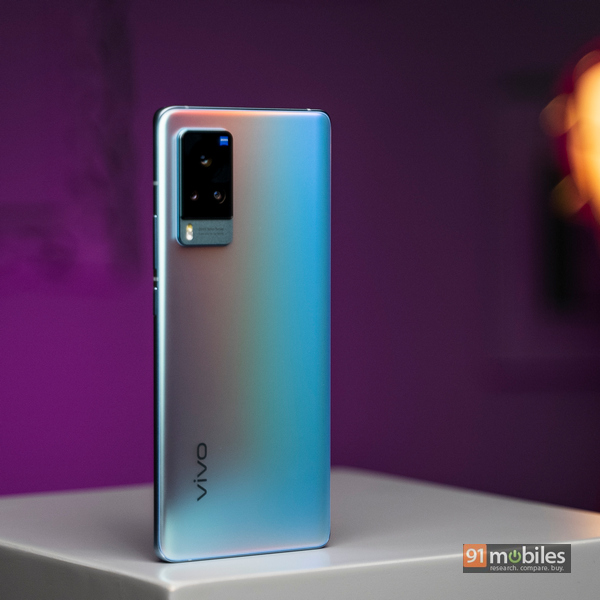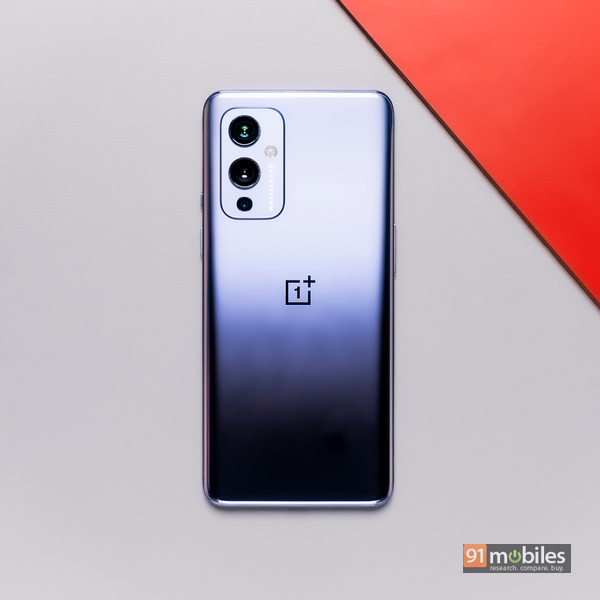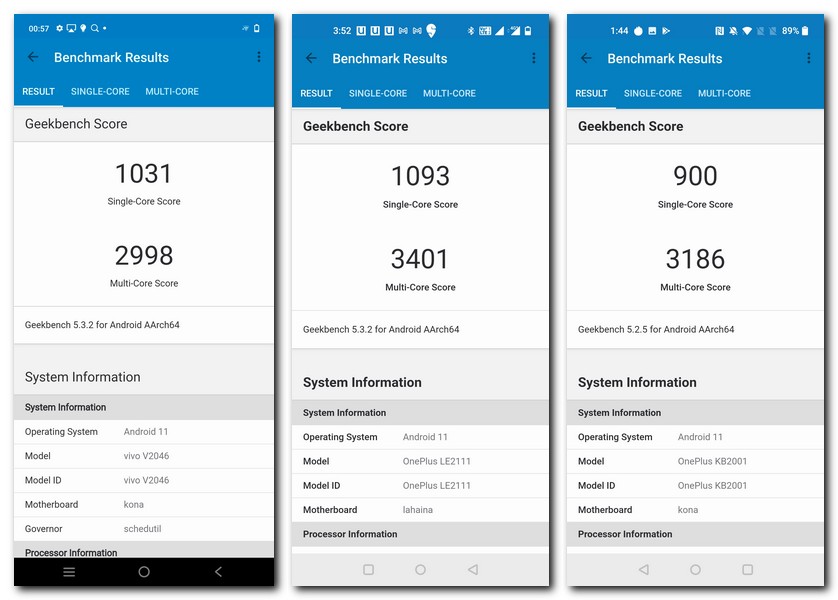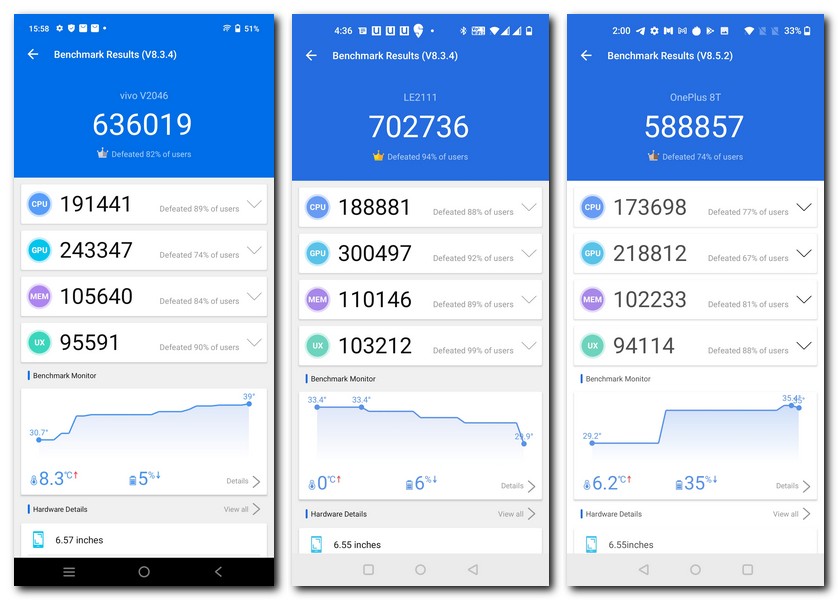
Vivo has announced its latest flagship smartphone lineup called the X60 series, comprising the Vivo X60, X60 Pro (review), and X60 Pro+. There are varying specs to each smartphone but all three are powered by Qualcomm’s flagship silicone. The Pro+ harbours the 5nm chipset Snapdragon 888, while the others are powered by the new 7nm Snapdragon 870 chipset. You can expect quite a few smartphones this year to use the SD870 SoC, and as such, it makes sense to see how much of a performance boost it can offer over and above the SD865, and how it stacks up against the obviously more powerful SD888. For this, I’ll be using the X60 Pro, the OnePlus 8T and the OnePlus 9. Priced at Rs 49,990, the Vivo X60 Pro does have its work cut out in terms of competition. You have the OnePlus 9 (review) priced exactly the same and powered by the Snapdragon 888 chipset. The OnePlus 8T (review) starts at Rs 42,999 and comes with the Snapdragon 865 chipset. Let’s understand these devices ad their chipsets more deeply through a benchmarks and gaming comparison.

The Qualcomm Snapdragon 870 is an amped-up version of the 865 from last year. It uses the same Cortex A77 cores that run the Kryo 585 Prime and Gold CPUs for performance, and the Cortex A55 cores with Kryo 585 Silver CPUs for efficiency. The main difference lies in the single 585 Prime CPU that can spin at 3.2GHz on the Snapdragon 870 as compared to 2.84GHz on the Snapdragon 865. The Snapdragon 888 is in a class above, as it packs in the new Cortex X1 core powered by a Kryo 680 Prime CPU that clocks at 2.84GHz. The rest are three Kryo 680 Gold CPUs part of the Cortex A78 core while the efficiency cores consist of four Cortex A55s that have the Kryo 680 Silver CPU. Both the 870 and 865 pack in the Adreno 650 for graphics, while the 888 has the Adreno 660 as its GPU. It is clear that the Snapdragon 888 has all the elements to come out on top and this comparison is to find out how far behind the other two are.

Table of Contents
Benchmarks
For a metric of how good the performance on a device is, benchmarks are usually the way to go. I have used Geekbench 5, Antutu, and 3DMark to assess the smartphones at hand and it should paint a reasonably good picture of each of their processing capabilities.
Geekbench 5

The benchmark for getting single-core and multi-core results is Geekbench 5 and it gives you an understanding of how the CPU performs under load. For the SD870-powered Vivo X60 Pro, the score generated for both tests was 1,031 and 2,998 respectively. The SD888-powered OnePlus 9 has the best score of 1,093 and 3,401, while the OnePlus 8T scored 900 and 3,189 with its SD865. From the results, we can see that all the phones have somewhat similar scores with the OnePlus 9 leading the pack. Surprisingly the multi-core score on the X60 Pro’s Snapdragon 870 is lower than the OnePlus 8T’s Snapdragon 865. However, the difference is made up in the single-core performance. In terms of percentage, the X60 Pro falls short by 12 percent in multi-core usage as compared to the Snapdragon 888-powered OnePlus 9 while single-core performance is about the same for both devices.
Antutu

The good thing about Antutu is that its overall score takes into consideration the phone’s CPU, GPU, Memory, and UX performance. You will notice that the X60 Pro has a decent overall score of 636,019 which is behind the OnePlus 9’s 702,736 score that is incidentally the highest I’ve seen on Antutu. OnePlus 8T, as expected, achieves the lowest score of the three at 588,857. X60 Pro’s higher score than the 8T comes from the better GPU, CPU, and memory performance. As compared to the OnePlus 9, the Snapdragon 870-powered X60 Pro falls short by 12 percent in overall performance.
3DMark

3DMark is always a good opinion as far GPU tests go, so I ran it on all three devices. The Vivo X60 Pro scored 4,212 overall on the WildLife benchmark. The SD888-equipped OnePlus 9 was obviously ahead with a score of 5,789 while the OnePlus 8T was last at 3,825. In terms of gains over the last generation OnePlus 8T, the X60 Pro is ahead by 10 percent while the OnePlus 9 moves ahead by as much as 34 percent.
While it was always obvious that the OnePlus 9 is going to be ahead in all metrics, but it is worth noting that the CPU performance remains about the same in all three devices. Let’s find out exactly how good the graphics-prowess is on the three devices through a gaming test.
Gaming
Running Call of Duty Mobile on the three phones for a period of 30 minutes should give us a rough idea of how the devices fare in terms of battery drop and temperature gained. The X60 Pro is at a slight disadvantage here since it houses a smaller 4,200mAh battery as compared to 4,500mAh on the rest.
Call of Duty Mobile

For this test, I will be running all the devices at Very High Graphics Quality (GQ) and Max Frame Rate (FR) with the Depth of Field, Bloom, Real-Time Shadows, Ragdoll effect, and Anti-Aliasing turned on. To be clear there is also an Extreme FR option available for both the OnePlus phones, but it seems that the update has not reached the Vivo X60 Pro. In any case, playing the game for 30 minutes saw the X60 Pro’s battery tank by 16 percent and temperature gained by 13 degrees. The OnePlus 9 drained a total of 12 percent battery while the temperature rose by 11 degrees. For the OnePlus 8T, the battery was down by 15 percent while the phone gained 14 degrees in temperature alongside.
Verdict
It appears that the Vivo X60 Pro and its Qualcomm Snapdragon 870 chipset do perform quite well, but the gains are not very significant over the OnePlus 8T’s Snapdragon 865. Sure, if you want the best graphics capabilities, the OnePlus 9 powered by Snapdragon 888 is a worthwhile choice. Even so, don’t expect a lot of improvements in the processing workload from the Snapdragon 870 (X60 Pro) to the Snapdragon 888 (OnePlus 9). All three phones are among the fastest devices you can find in the Android world as of now.












